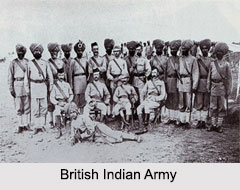 The British Indian Army comprised of various military units. One such unit was Indian Infantry Brigade, which was further divided into several other units. Some of these Indian Infantry Brigades are described below.
The British Indian Army comprised of various military units. One such unit was Indian Infantry Brigade, which was further divided into several other units. Some of these Indian Infantry Brigades are described below.
1st Indian Infantry Brigade
1st Indian Infantry Brigade was functional from 1939 to 1945. It was created in Abbottabad and was given "HQ Rawalpindi District" to handle until May, 1942. The unit is recorded in history as a participant in the Burma Campaign.
2nd Indian Infantry Brigade
2nd Indian Infantry Brigade was functional from 1939 to 1945. It was created in Rawalpindi. The unit was renamed 16th (Independent) Indian Infantry Brigade and then 116th Indian Infantry Brigade.
3rd Indian Infantry Brigade
3rd Indian Infantry Brigade was functional from 1939 to 1940. It was created at Jhelum in India. It was renamed the Frontier Reserve Brigade in August, 1943.
4th Indian Infantry Brigade
4th Indian Infantry Brigade was functional from 1939 to 1945. It was created as the 7th Indian Infantry Brigade and renumbered 4th in June, 1940. It was given the "HQ Rawalpindi District" to handle on creation. Some of the other units with which this Brigade provided service were 26th Indian Infantry Division, 14th Indian Infantry Division, 82nd (West Africa) Infantry Division, etc.
5th Indian Infantry Brigade
5th Indian Infantry Brigade was functional from 1939 to 1945. In September, 1939 it was turned into the 9th Indian Infantry Brigade and assigned to the 4th Indian Infantry Division. The unit went to Egypt and participated in the battles in North Africa. It went to Sudan with the 5th Indian Infantry Division. Returning to 4th Indian Division command, it participated in the Syria-Lebanon Campaign. The brigade once more returned to the 4th Division for the Italian Campaign and the Greek Civil War.
6th Indian Infantry Brigade
6th Indian Infantry Brigade was created before World War II and was functional till 22nd of December, 1941. In November, 1940, the brigade arrived in Singapore and came under the command of the 11th Indian Infantry Division. In December, 1941, the brigade was merged into the 15th Indian Infantry Brigade. The campaigns of the unit recorded in history are World War II, Malayan Campaign and Battle of Gurun.
7th Indian Infantry Brigade
The Poona Independent Brigade was re-designated as the 7th Indian Infantry Brigade and re-numbered 4th, in June, 1940. A second 7th Brigade was formed in June, 1940 and assigned to the 5th Indian Infantry Division. The unit is recorded in history as a participant in the World War II and the Sino-Indian War of 1962.
Other Indian Infantry Brigades
Some of the other Indian Infantry Brigades were 8th Indian Infantry Brigade, 9th Indian Infantry Brigade and 10th Indian Infantry Brigade.



















